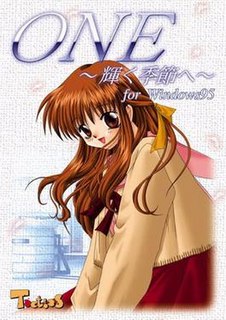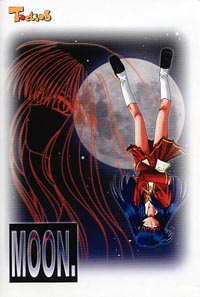
Kanon is a Japanese adult visual novel developed by Key and released on June 4, 1999 for Windows PCs. Key later released versions of Kanon without the erotic content, and the game was ported to the Dreamcast, PlayStation 2 and PlayStation Portable. The story follows the life of Yuichi Aizawa, a high school student who returns to a city he last visited seven years prior, and he has little recollection of the events from back then. He meets several girls and slowly regains his lost memories. The gameplay in Kanon follows a branching plot line which offers pre-determined scenarios with courses of interaction, and focuses on the appeal of the five female main characters by the player character. The game once ranked as the second best-selling PC game sold in Japan, and charted in the national top 50 several more times afterwards. Kanon has sold over 300,000 units across several platforms.

Da Capo is a Japanese adult visual novel developed by Circus's division Circus Northern which was released as a limited edition on June 28, 2002 playable on Windows as a CD-ROM; a DVD-ROM version followed on July 26, 2002. An English release was scheduled for December 25, 2008, and the game was available for a brief time on that date, but the title was pulled until January 20, 2009. Da Capo began as a series of prelude short scenarios in the Suika fandisc Archimedes no Wasuremono, and since the initial release, there have been numerous different versions released for Windows and PlayStation 2 over the years with updated scenarios and characters. The gameplay in Da Capo follows a plot line which offers pre-determined scenarios with courses of interaction, and focuses on the appeal of the seven female main characters.

Living for the Day After Tomorrow is a Japanese manga series written and illustrated by J-ta Yamada. The manga was serialized in Mag Garden's magazine Comic Blade Masamune between March 3, 2005 and June 15, 2007; five bound volumes were released in Japan. The manga was adapted into an anime series produced by J.C.Staff, which aired in Japan between October and December 2006. The story is about a young girl who grows older into an adult, and an adult woman who becomes younger, turning into a child. The anime is licensed by Sentai Filmworks, and a complete series boxset was distributed by Section23 Films on DVD on April 13, 2010.

Ayu Tsukimiya is a fictional character and the main heroine in Key's adult visual novel Kanon, followed closely by Nayuki Minase who is the only Kanon heroine to appear with Ayu on three of the official game covers released by Key. Ayu was created by Naoki Hisaya who wrote her scenario for the visual novel, and designed by Itaru Hinoue. Hisaya commented on how he thought Ayu was the one character in Kanon that he felt he grasped the best, but noted it was very difficult to write her character due to Ayu being primarily energetic. After Hinoue drew wings on Ayu's backpack, Hisaya suggested that they remove them due to spoiler reasons, and while Hinoue went along with it at the time, the wings were later included once again.

One: Kagayaku Kisetsu e is a Japanese adult visual novel, developed by Tactics, a brand of Nexton, released on May 29, 1998 playable on Windows PCs. The erotic content was later removed when the game was ported to the PlayStation. The story follows the life of Kōhei Orihara, a high school student who has fun spending time with several girls about his age, while at the same time he is gradually being drawn into a mystical alternate space known as the Eternal World.
Itaru Hinoue is the pseudonym of a Japanese artist from Osaka, Japan, who is one of the founding members of the visual novel brand Key under VisualArt's. Hinoue's choice of her pseudonym stems from the manga C by Shō Kitagawa; the protagonist in the manga was named Itaru Amano. Before forming Key, Hinoue worked for the company Tactics where she had a hand in the creation of the company's three games: Dōsei, Moon, and One: Kagayaku Kisetsu e. After forming Key, Hinoue has become known for her work on such titles as Kanon, Air and Clannad. Her dōjinshi circle is known as "Soldier Frog". In September 2016, Hinoue resigned from Key and VisualArt's.
Naoki Hisaya, born Naoki Hayashi, is a Japanese screenwriter who has worked for Tactics, Key and Siesta, but as of 2006, he is a freelance writer. He is well known for being the main writer of the popular visual novel Kanon while working under Key. Additional works include Moon, One: Kagayaku Kisetsu e, and Moon Childe. He is also known for being the original concept writer for Sola and Sora no Method. He later wrote the scenario for the action role-playing game Crystar. He also does work in a dōjin circle named Cork Board.

Moon is a Japanese adult horror visual novel developed by Tactics, a brand of Nexton, released on November 21, 1997, playable on Windows PCs. The game was described by the development team as a "Reaching the Heart AVG". The story follows the protagonist Ikumi Amasawa, a teenage girl who joins a mysterious organization called Fargo in the hopes of discovering why and how her mother died, who was a member of the same group. The gameplay in Moon follows a branching plot line which offers pre-determined scenarios with courses of interaction, and focuses on the three female main characters. The game ranked twice in the national top 50 for best-selling PC games sold in Japan.

Jun Maeda is a Japanese writer and co-founder of the visual novel brand Key under Visual Arts. He is considered a pioneer of nakige visual novels, and has mainly contributed as a scenario writer, lyricist, and musical composer for the games the company produces. His style was originally inspired by James Herbert Brennan, and is influenced by Haruki Murakami's novel Hard-Boiled Wonderland and the End of the World.
Shinji Orito is a Japanese musical composer originally from Hyōgo, Japan working for the visual novel brand Key under VisualArt's. Before forming Key, Orito worked for another software company named Leaf where he contributed to four games. After leaving Leaf, Orito transferred to another company named Tactics where he had a hand in the creation of three games for that company: Dōsei, Moon, and One: Kagayaku Kisetsu e. After forming Key, Orito has put much work into such famous titles as Kanon, Air and Clannad. Orito has been influenced by the famous Japanese composers Joe Hisaishi and Yuzo Koshiro.
Dicot is a Japanese musical duo. The members, Shino and Kana, both grew up in Fukuoka Prefecture and met at Fukuoka Women's Junior College in 1997 as first-year students. They quickly became good friends, decided to form a musical group, and before long they debuted in 2001 with Sony Music Entertainment Japan.

Kagayaku Sora no Shijima ni wa is the 8th single of Japanese girl group Kalafina. The title track is used as an ending theme and insert song in the anime series Kuroshitsuji II.
Life is the fourth full studio album by Angela Aki released on September 8, 2010.

O Maidens in Your Savage Season is a Japanese manga series written by Mari Okada and illustrated by Nao Emoto. It was serialized in Kodansha's shōnen manga magazine Bessatsu Shōnen Magazine from December 2016 to September 2019, with its chapters collected in eight tankōbon volumes. The manga is licensed in English by Kodansha USA. An anime television series adaptation by Lay-duce was broadcast on MBS's Animeism programming block from July to September 2019. A live-action television series adaptation was broadcast from September to October 2020.










